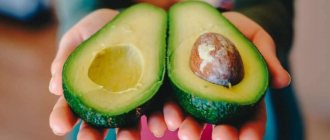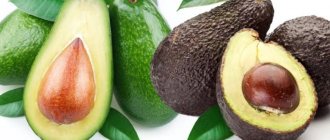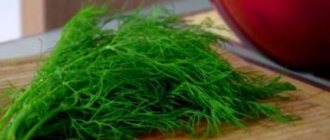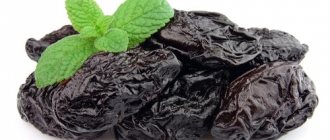The tropical fruit avocado, also called “Alligator pear”, is not uncommon in our stores. It comes to us from distant tropical countries, and it is not surprising that they come to us slightly unripe.
Of course, the best option would be to buy a ripe fruit, which can be distinguished by color.
Selecting fruit by skin color:
- The skin is pale green and takes several days to ripen.
- darker fruit will ripen in a day.
- the color is dark green or green-yellow when fully ripe.
- strongly darkened sign of overripeness or spoilage.
What are the signs to identify high-quality and low-quality fruit?
The quality of avocados in our country is regulated by GOST R 54689-2011, according to which the following fruits are sold:
- Healthy, clean, fresh, at the stage of consumer maturity, without signs of exposure to low temperatures.
- Visible damage caused by pests is not allowed.
- The color and shape of the fruit correspond to the varietal characteristics.
- The stalk is cut at the level of 1 cm, without mechanical damage.
- The presence of foreign odors and distortion of taste is excluded.
- Low-quality fruits also include fruits with obvious mechanical damage, signs of disease or rot, and the presence of mold.
How to choose
In addition to meeting quality standards, the taste is greatly influenced by the degree of ripeness of the fruit. To ensure that you have a real avocado on your table in the form in which it is usually eaten, look for fruits based on the following characteristics:
- Weight. When reaching ripeness, the avocado becomes noticeably heavier. Therefore, from two visually identical specimens, choose the one that weighs more. This is due to the maximum concentration of healthy juices and fatty acids. For the same reason, the fruits become elastic. When pressed, the pulp is slightly deformed, but quickly restores its shape.
- Bone. Of course, you won’t be able to see it at the time of purchase, but you can hear it. Bring the fruit to your ear and shake; when ripe, the seed will rattle.
- Color. The rich dark green color of the skin indicates that the product has reached the desired condition and is ready for consumption. In this case, the surface of the avocado under the cutting should be light yellow.
“Help” from other fruits
The ripening of any fruit is accelerated by ethylene gas. It is intensively produced by already ripe and overripe fruits.
At the same time, the “consumer properties” of avocados do not suffer in any way; the benefits are retained in full.
The process takes on average 2-3 days, but the exact time is impossible to determine. Its duration depends on:
- the initial ripeness of the avocado;
- activity of “auxiliary” fruits in terms of ethylene release;
- optimal microclimate in the room.
The procedure is extremely simple:
- Place the washed and dried fruits in a whole plastic or paper bag. Reusable packaging with a zipper or a plastic container that provides maximum airtightness is best. One “helper” is enough for 3-4 avocados.
- Ensure a constant room temperature within 20-24°C.
- Check ripeness daily.
When choosing what to put an avocado in one bag with, you need to take into account that the “champions” in ethylene synthesis are:
- bananas;
- red apples;
- tomatoes.
In order for it to ripen faster, you should not put any rotting fruit in the same bag with the fruit. They produce a minimum of ethylene, but actively spread pathogenic microflora; in a “closed space” infection occurs very quickly.
How to bring it to consumer ripeness at home
The homeland of avocado is very far from the store where you buy it, so fruits for export are always harvested unripe. They also end up on supermarket shelves in a not quite ripe state. This is not scary, the fruits will ripen perfectly at home in a few days at room temperature. If you don't have time to wait, there are several ways to speed up this process:
- Microwave. Prick the skin in several places with a fork. Microwave for 30 seconds on medium heat. Once cooled, use to prepare the desired dish.
IMPORTANT: Heat exposure may slightly distort the taste of the product, please take this into account when preparing dishes.
- Foil and oven. Wrap the fruits in foil and heat in the oven at 170-180 degrees for 10 minutes. Cool.
- Paper bag and apple. Place both fruits in one bag, wrap tightly and leave at room temperature for about a day.
- Cling film and refrigerator. This method will save an already cut fruit. If you split an avocado and see that it is unripe, put the cut pieces together, wrap tightly in film and put them in the refrigerator.
- Newspaper. Wrap the fruit in newspaper and leave to ripen in a warm, dark place.
Ways to store avocados at home
We save whole fruits
Store whole, unripe fruit at room temperature until it reaches ripeness (from 1-2 days to a week);
Whole, ripe fruit can be stored in the refrigerator for about 10 days;
If you bought an avocado that, for some reason, you didn’t need, you can freeze it as is (in its entirety) and defrost it when the need arises.
How to store a cut avocado
Cut into pieces, put into sealed containers and put in the refrigerator for no more than a day, this is required by SanPiN 2.3.2.1324-03.
Of course, it is better to cut into pieces as much fruit as you plan to use, but there are times when it is impossible to avoid leftovers, and they need to be preserved somehow. A few simple tips will help you extend the storage period to 5-6 days in the refrigerator:
- brush the surface of the pieces or the cut of the halves with olive oil;
- sprinkle with lemon juice;
- pack in a vacuum bag to completely eliminate contact with air;
- place the pieces in a container on an onion bed;
NOTE: Avocado does not absorb the smell of onions, so this proximity will not affect its taste in any way. But the shelf life will increase to 6-8 days.
- cover the slices with water (shelf life will last up to 48 hours).
Freezing
Depending on the type in which you freeze the avocado, it can be stored from 3 months to six months:
- Frozen whole fruits can be used for up to 6 months;
- Avocado slices or halves can be frozen in special bags or food containers. So you can use the product for 3-4 months;
- Make avocado puree, place it in ice cube trays, plastic cups or other small containers and store in the freezer for up to 5 months.
IMPORTANT: Strictly measure portions when preparing puree; freezing it again is unacceptable.
How long does it last in dried form?
Dried avocados can be stored for up to 8 months, and even longer if all conditions are met.
Cut it into thin slices and dry it in a special machine at 50 degrees for about 10-12 hours.
Store at room temperature, in a dark place with relative humidity no more than 75%.
NOTE: If you add finely chopped cilantro or parsley during drying, and immediately after it your favorite spices, you will get delicious avocado chips.
How to Preserve Avocados for a Year
Fruits are stored longer in pickled form than other fruits. Although this dish is not popular in our country, this cannot be a reason not to try it. You can pickle an avocado in any way that is familiar to you: prepare a sweet or salty marinade, add your favorite spices or do without them.
Pickled fruits packaged in sterilized containers can be stored for up to 18 months at room temperature.
General recommendations
Avocados are quite fiddly to store, so many housewives have difficulty storing them. Often, when buying fruit in a store, it is still in an unripe state, so it needs to be given another 5-7 days until it ripens. And then it begins to quickly deteriorate, even if you did not have time to cut it.
To preserve the taste and valuable properties of the fruit, avoiding its spoilage, follow the rules and tips:
- Low temperature. To keep avocados ripe longer, store them at temperatures between +2 and +12 degrees Celsius.
- High humidity. Preserving the ripeness, freshness and usefulness of the fruit is also ensured by humidity - from 85 to 95%.
- No sudden temperature changes. You don't need to constantly cool and heat your avocado by taking it out of the refrigerator and putting it back in, as this can cause it to rot.
- It is recommended to store the fruit in an upright position with the tail facing up.
- After cutting, do not remove the bone from it, this will increase the shelf life.
- There is no need to store avocados in a cooked or sliced state, as this will reduce their shelf life to 1-2 days.
- Limit access to air. Oxygen leads to oxidation of the fruit, the emergence of pathogenic microflora in it and premature spoilage, so it is recommended to wrap it tightly in foil, parchment paper or cling film.
Most often, avocados are stored in the refrigerator, since it is there that the temperature and humidity suitable for the fruit are maintained. However, when storing the opened fruit, make sure that there are no strong-smelling foods near it (for example, smoked fish).
A better place to place avocados is in the fruit and vegetable compartment or the top shelves in the refrigerator. The door should not be used for this because of the unstable temperature.
Let's prepare guacamole
This is perhaps the most popular avocado dish. To make guacamole paste you will need:
- 3 ripe avocados;
- 2 medium limes;
- 2 cloves of garlic;
- 0.5 cups olive oil;
- cilantro and salt - to taste.
Wash and peel the avocado and chop it as desired. Place the pieces in a blender bowl, squeeze out the lime juice, add herbs, salt and oil. Bring everything to a smooth paste. Place in a serving bowl and the dish is ready.
HELP: To make it easier to peel the fruit, make a deep vertical cut along the entire body and turn the halves in the opposite direction.
All the secrets are open, now you know the available ways to preserve avocados at home, all you have to do is choose the right one. Store correctly and be healthy!
Action plan
You need to take a fully ripe avocado, half a lemon, a fork, and a food container.
Peel the ripe fruit and remove the pit; make a puree from the remaining pulp. Well-ripe fruit can be easily mashed with a fork.
If the avocado is frozen for preparing a salad in the future, there is no need to puree it, just peel it and cut it into slices of the desired size. Next, sprinkle with lemon juice and place in a container.
Of course, after thawing, the taste will be less bright than that of fresh fruit.











